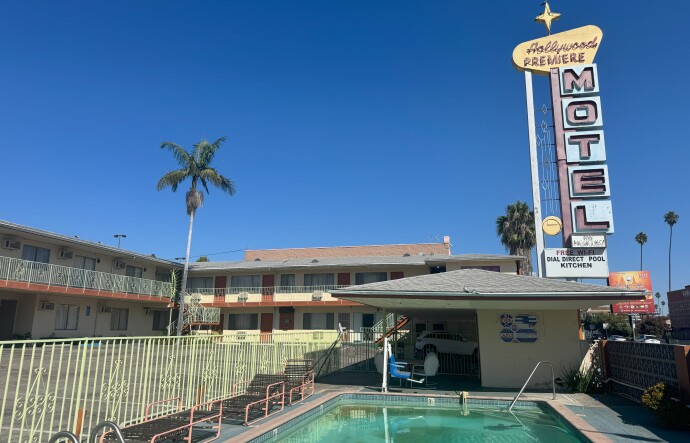With its towering blade sign and space-age aesthetic, the Hollywood Premiere Motel is a classic example of 1960s Googie architecture. The building also features the essential ingredients of its era: a dramatic porte-cochère entrance, requisite parking directly outside each room, and bold neon signage designed to catch the eye of motorists along Hollywood's bustling streets.
When the motel received Historic-Cultural Monument status by the Los Angeles City Council earlier this year, it made headlines as L.A.'s first landmarked motel. But buried in the original nomination was a detail that almost went unnoticed: architect Joyce Miller, who designed the mid-century modern building in 1960.
Miller represents a troubling pattern in Los Angeles preservation.
Uncovering women's roles in LA historical landmarks, one building at a time
The missing role of women in LA’s landmarks
Of the more than 1,300 Historic-Cultural Monuments designated since 1962, less than 2% recognize women's contributions. Miller's only the third woman architect to receive official recognition in the city's landmark program.
Miller worked independently as a woman architect in the 1960s and was active in the Southern California chapter of the Women's Architecture League, which provided scholarships and promoted architectural awareness during the second-wave feminist movement.
"Women have long been at the forefront of historic preservation work, but in how we recognize what places and stories make up our history, we have been very neglectful in recognizing women's roles," explains Christina Morris, Senior Program Director for the National Trust for Historic Preservation.
This glaring oversight sparked the L.A. Women's Landmarks Project, a partnership between the National Trust's Where Women Made History initiative and the Los Angeles Conservancy. The multi-year effort aims to correct more than 60 years of preservation practice that has largely erased women from the historical record.
‘Every place has a woman’s story to tell’
The project aims to amend existing landmark designations to include overlooked women's history, identify new sites worthy of recognition, and create public education programs to make these stories accessible.
Research conducted with USC Heritage Conservation graduate students has already uncovered dozens of iconic Los Angeles sites where women's contributions have been ignored.
The internationally famous Hollyhock House would not exist without Aline Barnsdall, who purchased the property, hired Frank Lloyd Wright, and envisioned creating a public art park.
Union Station's success depended on the Harvey Girls and architect Mary Colter's restaurant design. Even the Bradbury Building, one of L.A.'s most recognizable landmarks, was largely developed by Simona Martinez Bradbury, a Mexican woman who took over construction after her husband's death.
"Every place has a woman's story to tell," Morris notes. "We just need to start from that standpoint and be open to finding multiple and layered stories."
Systemic Change
Organizers say the project faces a fundamental challenge: women have been systematically written out of historical records.
"When you don't have access to property ownership, when you don't have your own last name, when you don't have your own bank records, it's really hard to trace someone through time," says Lindsay Mulcahy, who worked with the L.A. Conservancy to research Miller's story.
As such, the project is advocating to legitimize oral histories and community knowledge as valid sources for landmark designations.
Over the past year, Mulcahy and Morris have connected with over 70 individuals representing 40 organizations across Los Angeles, from historical societies in Boyle Heights and Little Tokyo to LGBTQ+ archives and professional associations to document the histories of women that have long been overlooked in the architecture space.
The project has also achieved significant policy developments. According to project organizers, Los Angeles City Council members recently worked on creating an official process for amending existing landmark designations to include previously overlooked histories.
Beyond buildings
Adrian Scott Fine, President and CEO of the Los Angeles Conservancy sees the work as expanding understanding of what constitutes heritage.
“Heritage comes in lots of different containers and wrappers,' he says. The building's significance lies in its intact representation of mid-century tourism, not modern amenities."
L.A. Women's Landmarks Project has so far identified over 200 potential sites for a closer look.
"We need to make sure the footprint—or rather, the footnote—of women are part of that story too," Fine says.


